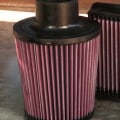When it comes to air filtration, experts use the Minimum Efficiency Report Value (MERV) to measure filter efficiency. This graph classifies filters according to their ability to capture particles, with ratings ranging from 1 to 16. The higher the rating, the better the filtering capacity of the air filter. The MERV ratings for different types of filters vary depending on their quality and manufacturer. Fiberglass filters are one of the most popular types of air filters used in homes. They are relatively inexpensive and easy to install.
However, they don't contribute much to indoor air quality. Fiberglass filters can only capture about 20% of particles that are between 3.0 and 10.0 microns in size. These particles include dust, carpet fibers, and pollen. Pleated filters are made from a medium fabric such as polyester or cotton. This material is organized into pleats to increase the filter surface area.
Therefore, filters with more pleats are more effective than those with fewer pleats. Pleated filters are more expensive than fiberglass filters but they are also more effective against contaminants. They can even capture smaller air contaminants such as pollen, pet dander, and mold spores. Pleated filters come in both reusable and disposable versions. UV light filters use shortwave UV light to kill bacteria and viruses.
The germicidal radiation from the UV lamp in these filters disinfects the air as it passes through. They are great for eliminating harmful microorganisms from your space, such as mold spores. However, UV light filters do little against contaminants like dust, so they are usually part of a more advanced filtration system such as HEPA filters. Electrostatic filters create static electricity by using a mixture of cotton and paper fibers. This static acts like a magnet and traps contaminants inside the filter screen.
This prevents allergens from spreading in your home, making electrostatic filters ideal for allergy sufferers. Electrostatic filters often also have a carbon filter to improve efficiency. These types of air filters come in flat panel or pleated versions and can be either washable or disposable. Multimedia filters consist of a paper-like material folded into folds inside a metal cabinet. While the filter is no larger than six inches, the pleated material can cover 75 square feet when unfolded.
This greater surface area makes media filters seven times more effective than standard types of air filters. The large surface area also explains the extended lifespan of media filters - they can last up to 2 years depending on the environment. The iWave air filter is often installed in the duct of an air conditioning system. It uses a patented technology called needle-tipped bipolar ionization which creates equal amounts of negative and positive ions. If you're buying an air filter for the first time, check out our guide to air purifiers for homeowners for guidance on choosing the best whole-house air filter for you. Flat filters are an ideal choice if you're on a tight budget but their popularity doesn't translate to effectiveness when it comes to smaller particles.
Electronic air filters offer portability and flexibility while extended multimedia filters take the shape of a box and have lots of filter media which makes them more effective and robust than fiberglass filters. Portable air filters or PACs have a high-efficiency particulate air filter mechanism which removes 99.97 percent of contaminants and allergens found in the air. When it comes to air conditioning problems, one of the most common is a dirty air filter which needs replacing for optimal performance. Different types of air filters have different advantages so it's important to consider your needs before making a purchase - whether it's for allergy sufferers or those living in industrial areas. We recommend using smart thermostats or smart air conditioning controllers that send reminders when it's time to clean your filter - an essential step that can often go unnoticed on your to-do list!.



